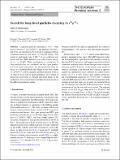Search for long-lived particles decaying to $$e ^\pm $$ e ± $$\mu ^\mp $$ μ ∓ $$\nu $$ ν
Author(s)
Aaij, R.; Beteta, C. A; Ackernley, T.; Adeva, B.; Adinolfi, M.; Afsharnia, H.; Aidala, C. A; Aiola, S.; Ajaltouni, Z.; Akar, S.; Albrecht, J.; Alessio, F.; Alexander, M.; Albero, A. A; Aliouche, Z.; Alkhazov, G.; Cartelle, P. A; Amato, S.; Amhis, Y.; An, L.; ... Show more Show less
Download10052_2021_Article_8994.pdf (1.869Mb)
Publisher with Creative Commons License
Publisher with Creative Commons License
Creative Commons Attribution
Terms of use
Metadata
Show full item recordAbstract
Abstract
Long-lived particles decaying to
$${e ^\pm } {\mu ^\mp } {\nu } $$
e
±
μ
∓
ν
, with masses between 7 and
$$50 \,\text {GeV/}c^2 $$
50
GeV/
c
2
and lifetimes between 2 and
$$50 \,\text {ps} $$
50
ps
, are searched for by looking at displaced vertices containing electrons and muons of opposite charges. The search is performed using
$$5.4 \,\text {fb} ^{-1} $$
5.4
fb
-
1
of
$$p $$
p
$$p $$
p
collisions collected with the LHCb detector at a centre-of-mass energy of
$$\sqrt{s} = 13 \,\text {TeV} $$
s
=
13
TeV
. Three mechanisms of production of long-lived particles are considered: the direct pair production from quark interactions, the pair production from the decay of a Standard-Model-like Higgs boson with a mass of
$$125 \,\text {GeV/}c^2 $$
125
GeV/
c
2
, and the charged current production from an on-shell
$$W $$
W
boson with an additional lepton. No evidence of these long-lived states is obtained and upper limits on the production cross-section times branching fraction are set on the different production modes.
Date issued
2021-03-26Department
Massachusetts Institute of Technology. Department of PhysicsPublisher
Springer Berlin Heidelberg
Citation
The European Physical Journal C. 2021 Mar 26;81(3):261
Version: Final published version